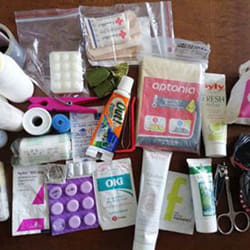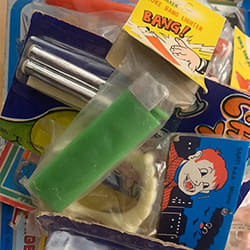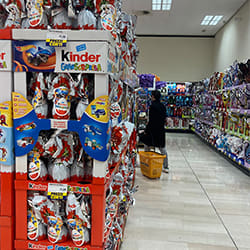・Paper straws and wooden forks
The movement to do away with plastic in Australia is really getting going, so nowadays you hardly ever see plastic straws. They are almost all made of paper. And most take-out forks and knives are made of wood or biodegradable materials. Frankly speaking, paper straws get soft and limp when wet, so they aren’t terribly convenient, but it seems nobody complains if it benefits the environment. It’s great that most Australians value the environment over convenience. They still sell plastic straws at supermarkets, but I think it is probably just a matter of time before they discontinue them.
・Barramundi
Barramundi is an edible freshwater fish found in Australia that can grow to 1.5 or 2 meters. For a freshwater fish, it tastes quite good and is popular among Australians. They use barramundi for fish and chips (grilled or deep-fried fish with fries, as a set) and grilled barramundi is just about always on restaurant menus. They sell fillets and slices at supermarkets, so please try it when you come to Australia. It’s delicious simply grilled with salt and pepper, some dill on top, and a squeeze of lemon.
・Amber necklaces for babies
They say that amber works as a remedy for teething babies, which seems to be something spreading throughout all Western countries, not just Australia. Amber is a brownish resin that looks like natural stone. The natural oil extracted from amber has a relaxing effect, promotes healing in wounds, and soothes pain. Parents put a necklace made of amber around their baby’s neck when they are teething. There were a lot of babies wearing amber necklaces when I first started living in Australia, and I was mystified, I thought they might be the latest Australian fad or maybe a sort of talisman, until I found out what they meant. There is an adorable contrast between a cute baby and he or she wearing such a sophisticated and sober brown necklace.
・Self-tanning products
In Australia, there are loads of self-tanning products that bronze your skin just by putting them on. Self-tanning products are popular in Australia because most people think that slightly tanned, healthy-looking skin is more appealing than the idea of “beautiful white skin.” You can always find them at supermarkets and drugstores. There are lots of different types, like mousses, creams, and sprays. There is such a strong demand for spray tan salons that on the flip side there are few tanning salons, because bronzing your skin with a spray is safer for you if you have white skin vulnerable to ultraviolet light and sunburn.
・Dips to start
Crackers and dips. The snack you have with a drink, like wine and so on.
Australian supermarkets have rows of many different types of dips. There are quite a lot of occasions when you eat crackers and dips as a kind of starter, like edamame beans with beer in Japan. Maybe it’s because they’re no-fuss, convenient, easy to eat at picnics or home parties, and everyone likes them.
There are lots of different dips, like avocado, onion, dried tomato, hummus (chickpeas), bell pepper, basil, smoked salmon, and more. Dips come in all sorts of flavors, and just that seems to be enough for people to write blogs about them, so I think my next article should be an in-depth exploration of dips, ha ha!
・Pipis
If you go to the beach in Australia, you might spot someone collecting something by digging their foot into the sand at the water’s edge. Living in that sand is a shellfish commonly called the “pipi” (scientific name Plebidonax deltoides). They are a glossy clam with a faint light purple tinge and look quite a lot like the “hamaguri” (Asian hard clam) in size and coloring. You can eat this clam and its flavor is exactly like hamaguri. They taste really good in clear soups, pasta, or steamed in wine. Once a long time ago I went with a friend to the beach at night and collected pipis. When I dug my foot into the sand on the beach and by the water’s edge I could feel the pipis with my foot, which was an interesting sensation, and I really got into it when I first started. Like “asari” (Japanese littleneck clams) and hamaguri, quite a bit of sand remains inside them if you don’t clean the sand out of them properly. Once I didn’t clean my pipis properly before cooking them, so they were crunchy from the sand, not something you could eat, ha ha.
I have actually been staying in Japan for a long time now, about 5 months, so I’m sorry but I don’t have any photos to go with my article.
But I thought it might be fun for anyone going to Australia in the future to discover these things in the flesh there.
My next article will be titled What Do They Have in Japan but You Hardly See at All in Australia? - Part 2
- 2023.12.07
- What Australian Things Are Not So Common in Japan? - Part 2




























































